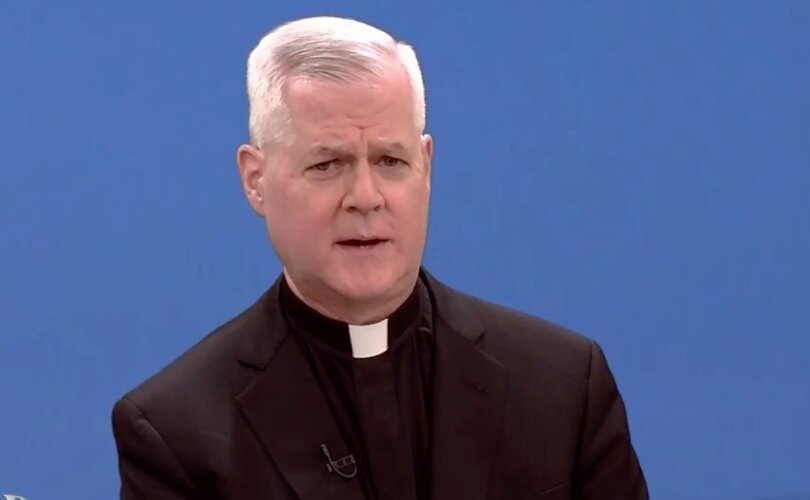ROME (LifeSiteNews) — A respected canon lawyer and regular EWTN commentator has issued a canonical critique of the Synod on Synodality and warned that, by allowing lay people to vote, the event could “cause immense harm to the life and mission of the Church.”
Father Gerald Murray, JCD, made his comments at a recent conference in Rome, held on the eve of the Synod on Synodality, where he was joined on the speaker’s table by Cardinal Raymond Burke and Professor Stefano Fontana. (Murray’s talk, given in Italian, is available in English here.)
Canonical status of the synod
While known more commonly as the Synod on Synodality, the synod is technically and officially denoted by the Vatican as the 16th Ordinary General Assembly of the Synod of Bishops. As the name denotes, a synod is comprised of bishops and is clearly defined as such in Canon Law.
But, as Murray noted, on April 26 Pope Francis bent this rule, allowing men who are not bishops and women to participate as voting members in a synod for the first time. The pontiff announced it to the world via a press release from the media office of the General Secretariat of the Synod.
READ: Pope Francis to personally select lay men, women to form up to 25% of Synodal vote
As such, “the episcopal and hierarchical nature of the Synod of Bishops effectively came to an end” with this “unsigned document from the Press Office of the General Secretariat of the Synod that announced the extension of participation in the Synodal Assembly to non-bishop members,” said Murray.
Murray argued that even the process by which this change was effected was wrought with errors. He noted that the press release which which announced the introduction of lay voting members had “no citation of a papal decree” which enacted the change.
While Canon 51 demands a decree is “to be issued in writing,” Murray added that “I am not aware that such a decree has been published” and thus “the reference in the [Synod’ press release] document to a papal approval of a change to existing canonical provisions is not sufficient to establish legal certainty in this matter.”
READ: Here’s what will take place at the Synod on Synodality this October
Given that the synod’s press office “does not possess the canonical authority” to effect such a change, and that the synod’s document did not state that “Pope Francis approved of the contents of the Press Office document and ordered its publication,” Murray argued that:
Thus, the document cannot be said to issue from the hand of Pope Francis. Thus, the General Assembly of the Synod and all its acts would be subject to a technical complaint of canonical nullity, absent the publication of a papal decree giving legal force to the extension of membership in the Synodal Assembly to non-bishops.
Lay or episcopal synod?
While the Secretariat for the Synod argued in April – and has consistently maintained – that the “episcopal specificity of the Synodal Assembly is not affected, but even confirmed” by allowing lay voters, Murray disagreed with this. “What we now have is a Synod of Bishops and Non-Bishops; we no longer have a Synod of Bishops… When non-bishop members with voting rights are introduced into an assembly of bishops with voting rights, the assembly ceases to be episcopal in nature.”
READ: Synod on Synodality members ordered to observe perpetual secrecy about discussions
Lay voters in the synod thus transform the event into “a totally different assembly in which lay people who are not sacramentally conformed by holy orders to Christ the High Priest will be treated in law as equal to bishops,” he said. Such a change, added Murray, ignores the “essential distinction between the ordained and the non-ordained in the Church,” which has been established by Christ.
To create confusion in this matter by making non-bishops equal in law to bishops at the General Assembly of the Synod does harm to the Church by obscuring the roles of shepherd and sheep, creating the false impression that the hierarchical authority of the bishops can be legitimately exercised by the non-ordained.
Such an understanding would violate the divinely established nature of the Church.
Problems with the working document
As reported by LifeSiteNews, the document underpinning the current synod, the Instrumentum Laboris, is a text that contains topics such as women’s diaconal “ordination,” married Latin rite priests, and an alleged need to “welcome” the “remarried divorcees, people in polygamous marriages, LGBTQ+ people.”
READ: Major Synod on Synodality document highlights need to ‘welcome’ polygamists, ‘LGBTQ+ people’
Its promotion of questions about topics that have already been clearly answered by the Church, comes at the expense of a promotion of authentic Catholic doctrine on a number of issues.
Murray highlighted this problem, asserting that through it “expectations are raised that a new Church, the Holy Spirit-inspired Synodal Church, will emerge in which everyone will feel seen, recognized, welcomed, accepted, accompanied, cared for, listened to, valued, not judged, and so on.”
This emotion-centered focus is the template for the hoped-for ‘soft’ revolution in the Church in which Catholic doctrines that contradict decadent Western sexual mores and radical feminist claims of oppression in the Church are framed as obsolete, regrettable, and needless sources of discord and alienation, as holdovers from a cruel past. These doctrines, of course, need to be jettisoned, lest anyone feel unwelcome.
Continuing his assessment of the new, loftier role of the laity in the synod, Murray drew from the Instrumentum Laboris to show that “in the new synodal Church it is the people who instruct the bishops on the meaning of the Faith.”
Participants in the Synod on Synodality are now spending the entire process in discussions of varying styles based on the Instrumentum Laboris and key themes contained within it.

